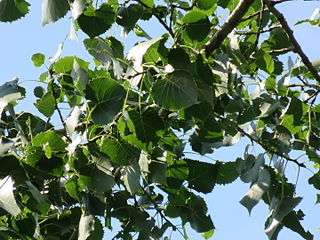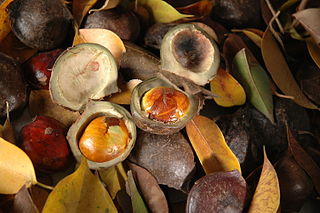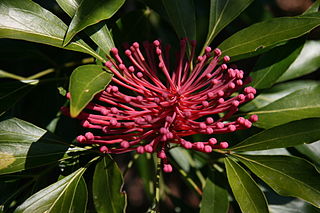
Araucaria araucana is an evergreen tree growing to 1–1.5 m (3–5 ft) in diameter and 30–40 m (100–130 ft) in height. It is native to central and southern Chile and western Argentina. Araucaria araucana is the hardiest species in the conifer genus Araucaria. Because of the prevalence of similar species in ancient prehistory, it is sometimes called a living fossil. It is also the national tree of Chile. Its conservation status was changed to Endangered by the IUCN in 2013 due to the dwindling population caused by logging, forest fires, and grazing.

Acer saccharinum, commonly known as silver maple, creek maple, silverleaf maple, soft maple, large maple, water maple, swamp maple, or white maple, is a species of maple native to the eastern and central United States and southeastern Canada. It is one of the most common trees in the United States.

Yucca brevifolia is a plant species belonging to the genus Yucca. It is tree-like in habit, which is reflected in its common names: Joshua tree, yucca palm, tree yucca, and palm tree yucca.

Pinus strobus, commonly denominated the eastern white pine, northern white pine, white pine, Weymouth pine (British), and soft pine is a large pine native to eastern North America. It occurs from Newfoundland, Canada west through the Great Lakes region to southeastern Manitoba and Minnesota, United States, and south along the Appalachian Mountains and upper Piedmont to northernmost Georgia and perhaps very rarely in some of the higher elevations in northeastern Alabama. It is considered rare in Indiana.

Magnolia grandiflora, commonly known as the southern magnolia or bull bay, is a tree of the family Magnoliaceae native to the southeastern United States, from Virginia to central Florida, and west to East Texas. Reaching 27.5 m (90 ft) in height, it is a large, striking evergreen tree, with large dark green leaves up to 20 cm long and 12 cm wide, and large, white, fragrant flowers up to 30 cm (12 in) in diameter.

The curry tree is a tropical to sub-tropical tree in the family Rutaceae, and is native to Asia. The plant is also sometimes called sweet neem, though M. koenigii is in a different family to neem, Azadirachta indica, which is in the related family Meliaceae.

Taxodium distichum is a deciduous conifer in the family Cupressaceae. It is native to the southeastern United States. Hardy and tough, this tree adapts to a wide range of soil types, whether wet, salty, dry, or swampy. It is noted for the russet-red fall color of its lacy needles.

Attalea maripa, commonly called maripa palm is a palm native to tropical South America and Trinidad and Tobago. It grows up 35 m (115 ft) tall and can have leaves or fronds 10–12 m (33–39 ft) long. This plant has a yellow edible fruit which is oblong ovoid and cream. An edible oil can be extracted from the pulp of the fruit and from the kernel of the seed.

Moringa oleifera is a fast-growing, drought-resistant tree of the family Moringaceae, native to the Indian subcontinent. Common names include moringa, drumstick tree, horseradish tree, and ben oil tree or benzolive tree.

Leucadendron argenteum is an endangered plant species in the family Proteaceae, which is endemic to a small area of the Cape Peninsula, South Africa. Most grow in and around the city of Cape Town, but outlying populations exist near Somerset West (Silwerboomkloof), Paarl and Stellenbosch. It is a protected tree in South Africa.

Populus deltoides, the eastern cottonwood or necklace poplar, is a cottonwood poplar native to North America, growing throughout the eastern, central, and southwestern United States as well as the southern Canadian prairies, the southernmost part of eastern Canada, and northeastern Mexico.

Alloxylon flammeum, commonly known as the Queensland tree waratah or red silky oak, is a medium-sized tree of the family Proteaceae found in the Queensland tropical rain forests of northeastern Australia. It has shiny green elliptical leaves up to 18 cm (7.2 in) long, and prominent orange-red inflorescences that appear from August to October, followed by rectangular woody seed pods that ripen in February and March. Juvenile plants have large deeply lobed pinnate leaves. Previously known as Oreocallis wickhamii, the initial specimen turned out to be a different species to the one cultivated and hence a new scientific name was required. Described formally by Peter Weston and Mike Crisp in 1991, A. flammeum was designated the type species of the genus Alloxylon. This genus contains the four species previously classified in Oreocallis that are found in Australasia.
Anadenanthera colubrina var. cebil is a mimosa-like timber tree native to Caatinga and Cerrado vegetation in Argentina, Bolivia, Brazil, Paraguay and Peru. It has also been introduced to Mauritius. It grows up to 25 m (82 ft) tall, with a trunk diameter of 60–90 cm (24–35 in). The tree's mimosa-like leaves range in length from about 7–20 cm (2.8–7.9 in). The flowers are cream-colored and arrive in the spring. The seed pods are fairly straight and contain about 8 to 15 seeds each. The seeds are flat, average each about 1.5 cm (0.59 in) in diameter and have an average mass of about 0.125 g (0.0044 oz) each. The tree's wood has a density of about 840 kg/m3 (1,420 lb/cu yd).

Archidendron pauciflorum, commonly known as Djenkol, Jengkol or Jering is a species of flowering tree in the pea family, Fabaceae. It is native to Southeast Asia, where the seeds are a popular dish. They are mainly consumed in Thailand, Malaysia, Myanmar, and Indonesia and prepared by frying, boiling, or roasting and are also eaten raw. The beans are mildly toxic due to the presence of djenkolic acid, an amino acid which causes djenkolism. The beans and leaves of the djenkol tree are traditionally used for medicinal purposes such as purifying the blood. To date, djenkol is traded on local markets only.

Hicksbeachia pinnatifolia is a small tree in the family Proteaceae. This rare species is native to subtropical rainforest in New South Wales and Queensland in Australia. Common names include red bopple nut, monkey nut, red nut, beef nut, rose nut and ivory silky oak. The tree produces fleshy, red fruits during spring and summer. These contain edible seeds.

Telopea mongaensis, commonly known as the Monga waratah or Braidwood waratah, is a shrub or small tree in the family Proteaceae. Endemic to Australia, it grows at high altitude in south eastern New South Wales, where it is often seen in moist areas at the edge of rainforest or by streams in eucalyptus forests. Growing to 6 m (20 ft) high, it has narrow green leaves 4–18 cm (1.6–7.1 in) in length, and 0.5–2 cm (0.20–0.79 in) wide. In spring bears many red flowerheads, each made up of 28 to 65 individual flowers.

Alloxylon pinnatum, known as Dorrigo waratah, is a tree of the family Proteaceae found in warm-temperate rainforest of south-east Queensland and northern New South Wales in eastern Australia. It has shiny green leaves that are either pinnate (lobed) and up to 30 cm (12 in) long, or lanceolate (spear-shaped) and up to 15 cm (5.9 in) long. The prominent pinkish-red flower heads, known as inflorescences, appear in spring and summer; these are made up of 50 to 140 individual flowers arranged in corymb or raceme. These are followed by rectangular woody seed pods, which bear two rows of winged seeds.

Xylomelum pyriforme, commonly known as the woody pear, is a species of plant in the family Proteaceae native to eastern Australia. It grows as a large shrub or small tree to five metres high.

Guazuma ulmifolia, commonly known as West Indian elm or bay cedar, is a medium-sized tree normally found in pastures and disturbed forests. This flowering plant from the family Malvaceae grows up to 30m in height and 30–40cm in diameter. It is widely found in areas such as the Caribbean, South America, Central America and Mexico serving several uses that vary from its value in carpentry to its utility in medicine.

Leucospermum conocarpodendron, is the largest species of the genus reaching almost tree-like proportions of 5–6 m (16–20 ft) high, with a firm trunk that is covered in a thick layer of cork that protects it from most fires, with greyish or green narrow or broad inverted egg-shaped leaves with three to ten teeth near the tip, and large yellow flowerheads, with firm, bent, yellow styles that stick far beyond the rest of the flower and give the impression of a pincushion. It is commonly known as the tree pincushion in English or goudsboom in Afrikaans. They natural occur near Cape Town, South Africa. Two subspecies are distinguished. L. conocarpodendron subsp. conocarpodendron, that has greyish leaves because they have a covering of felty hairs. L. conocarpodendron subsp. viridum, has green leaves that lack felty hairs. Flowers can be found between August and December.



















